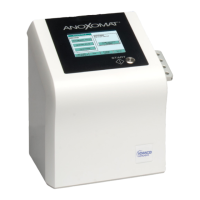22
Anoxomat® III User’sGuide
Chapter 4
Maintenance
This chapter describes the procedure for maintaining your instrument.
Make sure the Anoxomat is unplugged when you clean or maintain it.
4.1 Maintaining the Anoxomat
The Anoxomat requires little maintenance; however,
some points should be observed:
• Never allow jar tubes to hang loose when unattached,
as the system always tests all jar tubes to check for
attached jars. Instead, place unused tubes in the
holder on the side of the system.
• Clean the housing with a slightly damp cloth only. You
can use isopropyl alcohol or diluted bleach. Avoid
spraying liquids onto the Start button switch.
• Visual checks for cracks and kinks should be made
regularly on all tubing and external cabling. In case of
damage, new tubing and external cabling should be
ordered and replaced immediately. Use only
replacement parts from Advanced Instruments or an
authorized distributor.
4.2 Maintaining jars
It is recommended that Anoxomat jars be stored
between 0˚C and 50˚C.
It is advisable to perform the following maintenance
every three months on the jars:
• Spray a little lubricant spray containing Teflon in the
snap-shut coupling to keep the coupling lubricated.
• Clean and apply acid-free petroleum jelly on the
rubber O-ring of the lid, only with the standard jars.
Clean and leave dry (no petroleum) the seal in the
ergonomic jar lids.
To be certain that the jars are maintained correctly and
regularly, a small box with necessities to maintain all jars
working with the Anoxomat (standard jars or Ergonomic
jars) is available. This kit includes 10 replacement snap
shut couplings (these cannot be cleaned, and can only
be lubricated with a lubricant spray containing Teflon),
tools, cleanser and lubricant. The Jar Maintenance Toolkit
(Product No. MT2000) is available from your Anoxomat
distributor.
Jar cleaner and disinfectant
The Standard and Ergonomic jars are never to be
cleaned with alcohol, and are not to be exposed to
temperatures greater than 80˚C.
Advanced Instruments recommends using a bleach-
alternative product. Sodium hypochlorite (i.e., bleach)
solutions are not recommended for disinfection of the
jars because they damage the inside of the jar over time.
Disinfection eectiveness can vary considerably
depending on a number of factors including cleanliness,
target organisms, and disinfectant concentration. For
these reasons, the level of disinfection and disinfection
eectiveness is the responsibility of the customer.

